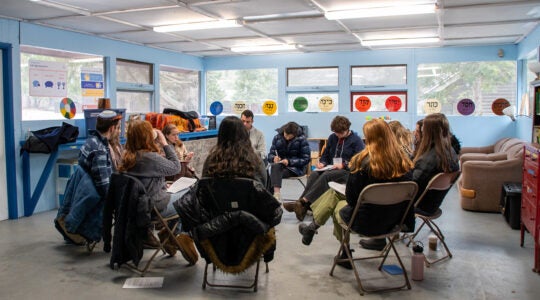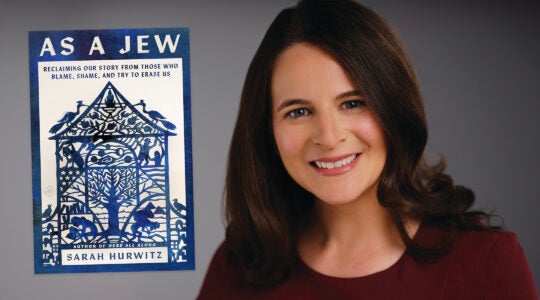A newly released report by the Task Force on Welcoming Interfaith Families of the New York UJA-Federation has been hailed by some as a breakthrough (“UJA-Fed. Launches Outreach To Intermarrieds,” Dec. 9).
To the extent that it calls for additional funding for Jewish education directed at intermarried couples and new sensitivity training for outreach workers, the report represents a shift in resources. But in its assumptions about intermarriage, it encapsulates the conventional and unsubstantiated wisdom about how best to address intermarriage.
The underlying premise of the report is that large numbers of intermarried families containing a Jewish-born partner remain aloof from Jewish life because they do not feel welcome. Yet nothing in the report provides evidence that this is the cause for the staggeringly high rates of non-affiliation characteristic of intermarried families in this area and most others around the country.
Even those with a cursory knowledge of Jewish life are aware that in quite a few local Reform and Reconstructionist congregations as many as half their younger members are intermarried. It’s hard to imagine they are moved to join if those congregations are as inhospitable as imagined by the task force. At a time when the buzzwords of Jewish communal life are “inclusiveness,” “diversity” and “big-tent Judaism,” the assumption that a lack of welcoming is the reason for widespread non-affiliation defies credulity.
Moreover, several recent studies conclude that intermarried families by no means feel unwelcome. Two years ago, a task force of the American Jewish Committee looking at “Non-Jews in the Jewish Community” found that “few non-Jews report unpleasant experiences or negativity from Jewish settings.” A recent study of Jewish summer camp usage in the Midwest also concluded that intermarried families do not feel unwelcome in the Jewish community. Indeed, data included in the federation’s task force report reveals that only 18 percent of intermarried families in the New York area “feel it is very important to be part of a Jewish community” as compared to 95 percent of the in-married.
Why, then, does the task force insist that a lack of welcoming is the root cause of non-affiliation? The answer, perhaps, lies in its blithe assumption, repeated several times, that intermarried families are part of the Jewish population. It is one thing to reach out to intermarried born-Jews and children being raised exclusively as Jews by their intermarried parents. But is it not insulting to people of other faiths or no religion whose only Jewish connection is through a family member to assume that they are part of the Jewish community?
Missing entirely from the task force report are the voices of the intermarried and their children, explaining their complex or non-existing relationship with organized Jewish life. Thanks to websites such as Interfaithfamily.com, it is easy to access their views. Many write candidly about the deep religious fissures running through families, about the impossible dilemmas posed by dual-religion households, about personal psychological barriers to participation in Jewish life. Rather than take the intermarried at their word about why they do not wish to participate in Jewish life, the task force knows better: the root cause is found not in family dynamics or indifference but in the failure of the Jewish community to be sufficiently welcoming.
This misreading has been abetted by some outreach advocates claiming they have found the magic bullet. One study in particular is invoked endlessly to this effect. A few years ago, the Boston Jewish community survey found that 60 percent of intermarried families claimed to be raising their children as Jews, double the national rate. The Boston federation immediately declared victory by asserting that this high percentage is a result of its strong outreach efforts.
But does this finding prove anything? Because survey questions can be understood in different ways, “raising children as Jews” may refer to an aspiration or to actual practice, to “Jewish and something else” or to some vague sense of Jewishness. Even more important, there is no evidence that higher rates of participation are the result of outreach, rather than other possible factors. To measure the impact of outreach would require tracking people before, during and after their exposure to “welcoming” efforts and to take all kinds of other variables into account. Rather than do the hard work of proving what is efficacious, we rely upon wishful thinking, while ignoring the damage caused by “welcoming “at any price.
A case in point: the chairman of the task force asserted to this newspaper, “We are not endorsing interfaith marriage or condemning it.” A generous reading of such stunning “non-judgmentalism” might attribute it to pragmatism. The task force was to come up with a “welcoming” program and, by golly, it has. Let others worry about questions of right and wrong.
As a statement about where the largest Jewish community in the United States stands on the religious and communal imperative to perpetuate Jewish life through endogamy, the neutrality of the UJA-Federation of New York is a devastating commentary on our times. In the name of “welcoming,” the federation no longer asserts what Jews have understood for millennia: that leaving aside exceptional cases when conversion or unambiguous commitment to Jewish life are embraced by the intermarried, intermarriage is bad for the Jewish people and for the perpetuation of Judaism. In abandoning the Jewish commitment to endogamy, the task force does not reflect the views of large populations of traditional Jews in greater New York.
Jack Wertheimer is professor of Jewish history at the Jewish Theological Seminary. His most recent book is The New Jewish Leaders: Reshaping the American Jewish Landscape.
The New York Jewish Week brings you the stories behind the headlines, keeping you connected to Jewish life in New York. Help sustain the reporting you trust by donating today.




